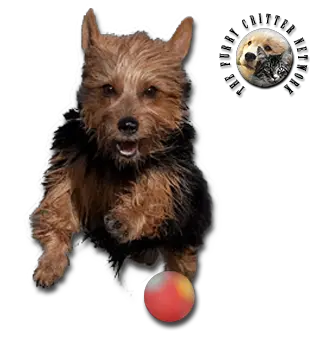Breed Standard
Head: Long. Flat skull. Slight stop. Strong, powerful muzzle. Strong jaws.
Ears: Small, pointed. Held erect.
Eyes: Small, oval, wide set. Dark brown color.
Body: Long, solidly built. Strong, slightly arched neck. Well developed forechest. Deep, moderately broad chest. Ribs well sprung. Strong loin. Horizontal topline.
Tail: Docked. Carried gaily but not over the back.
Hair: Approx. 6 cm (2,4 in) long; straight, rough, and dense. Short, soft undercoat. The muzzle, lower legs, and feet are free of long hair.
Coat: Blue, steel blue, or dark gray-blue with rich tan markings on the face, ears, underbelly, lower legs, feet, and around the anus. Sandy or red.
Size: Approx. 25 cm (9,8 in).
Weight: 3,6 to 6,3 kg (8-14 lb).
History
The Australian Terrier is descended from the rough coated type terriers brought from Great Britain to Australia in the early 19th century. The ancestral types of all of these breeds were kept to eradicate mice and rats. The Australian Terrier shares ancestors with the Cairn Terrier, Shorthaired Skye Terrier, and the Dandie Dinmont Terrier; Yorkshire Terriers and Irish Terriers were also crossed into the dog during the breed's development.
Development of the breed began in Australia about 1820, and the dogs were at first called the Rough Coated Terrier. The breed was officially recognised in 1850, and later renamed as the Australian Terrier in 1892. The Australian Terrier was shown at a dog show for the first time in 1906 in Melbourne, and was also shown in Great Britain about the same time. The Kennel Club (UK) recognised the breed in 1933. The American Kennel Club recognised the Australian Terrier in 1960, and the United Kennel Club (US) in 1970. It is now recognised by all of the kennel clubs in the English speaking world, and also is listed by various minor kennel clubs and other clubs and registries.
Behavior
This lively, courageous dog is affectionate and cheerful, but has a true terrier personality. Firm training is necessary. In general, adult male terriers do not get along well with other adult male dogs. Since the Australian Terrier was also bred for companionship, they tend to be very people friendly, and enjoy interacting with people.
This active dog needs plenty of exercise. Daily brushing is required.
Function
Pet.
Health
Currently there are no known health issues outside of the normal issues associated with this size canine.






